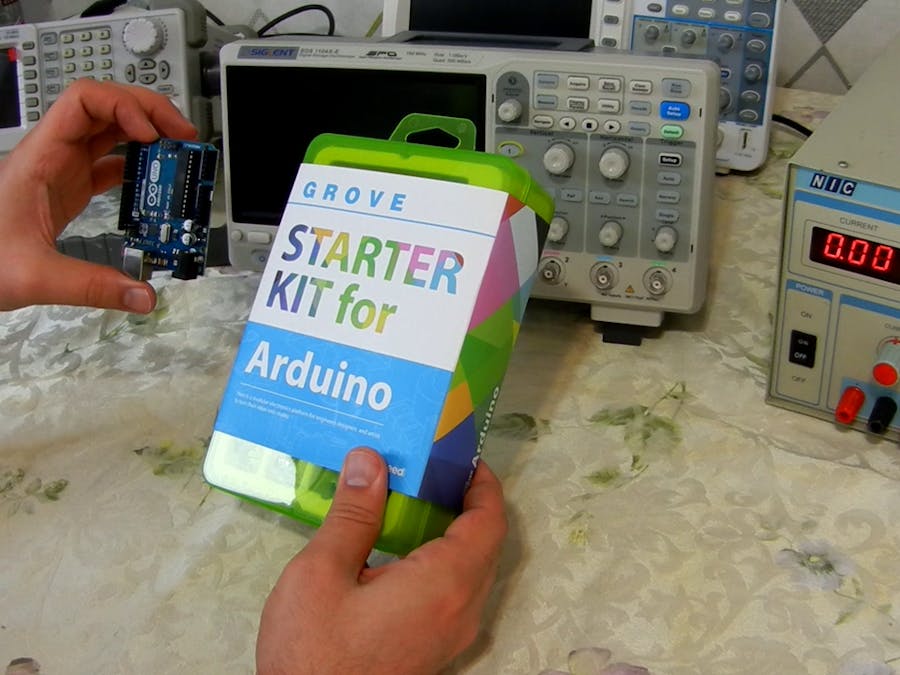Grove starter kit for Arduino
Nowadays, Arduino is one of the first easy-to-use electronic platforms that beginners use to learn new concepts and overcome their first electronic design challenges. Seeed Studio has produced a nice starter kit that reduces the learning curve of this process. Grove starter kit for Arduino is a modular electronic platform for quick prototyping. Basically, it includes one Arduino-Uno compatible base-shield, 10 modules, and one servo motor.
[1] Enclosure
The first interesting aspect of this product is the kit’s enclosure. Each board/module fits in its own defined space, and wires and other components have gathered at the bottom of the box. This helps to keep your working table orderly and tidy. You won’t miss any board or component! Figure 1 and figure 2 show the enclosure and modules.
[2] Quality Inspection
By performing a visual inspection, we can realize that the manufacturing/soldering quality of the modules, base-shield, cables, and components are good and have not been selected from low-quality materials. Figure 3 shows all kit materials/components in one picture.
[3] Product Analysis
Grove starter kit for Arduino consists of several modules/parts. In this section, I will examine each part individually. Really I admire the provision of a one-sheet manual that you can instantly find necessary information about all modules/components. The quality of the paper is acceptable (Figure 4).
[3-1] Base-Shield
Figure 5 shows the base-shield. It is designed to fit the Arduino-Uno board. Figure 6 shows the mounted shield. It creates an interface for the kit’s modules to be connected to the Arduino-Uno. Just you need to pick the proper cable and connect your desired module to the base-shield. All module cables/connectors consist of 4 wires.
[3-2] Smart Relay
As it is clear, this module is used to mechanically switch ON/OFF the loads. It looks like the relay is supplied from the Arduino’s main supply rail. I don’t think this could cause a problem for this kit and these kinds of applications, however, it is not a good practice that a designer shares the relay’s supply with other sensitive parts such as an MCU. The relay switch-action or its sudden current draw could cause instability in other circuits, especially if several relays are used. Figure 7 shows a picture of the smart relay module.
[3-3] LCD with RGB Backlight
This is a very nice module that only needs 2-wires (I2C) to communicate with the Arduino board (Figure 8). Good quality.
[3-4] Buzzer
Nothing is special with this module. It allows you to connect it to the Arduino and generate desired sounds. Figure 9 shows a picture of this module.
[3-5] Sound Sensor
An electret microphone and an LM358 amplifier are two main components of this module. You can read the amplifier output using the Arduino’s analog pin to examine the sound level, for instance, to activate a switch or relay. In my opinion, a rail-to-rail opamp can perform better, such as MCP601/2 or similar. Figure 10 shows a picture of the sound sensor.
[3-6] Touch Sensor
By using this module, you can make projects with a touch button feature. I can see a small 6 pin chip on the board that is for sure used to prepare a good sensing signal for the Arduino. Figure 11 shows a picture of this module.
[3-7] Rotary Angle Sensor
This module is a potentiometer that you should read its voltage variations (0 to 5V) by the Arduino’s analog inputs. The quality of the potentiometer is acceptable. A picture of this module has been demonstrated in figure 12.
[3-8] Temperature Sensor
I can see this board uses an SMD NTC sensor and an LM358 amplifier. So the output is analog and must be read using an analog-input. I suggest using a rail-to-rail opamp instead of LM358. Figure 13 demonstrates this module.
[3-9] Light Sensor
So as the name says, this sensor is used to sense the intensity of the light (figure 14). So it means the output voltage varies by any change in the environmental light. This module uses an LM358 to amplify the small sensor voltage to a meaningful magnitude for the ADC of the Arduino. Here also I suggest using a rail-to-rail opamp instead of an LM358.
[3-10] Button
This module is a tactile push button that is naturally used as a momentary ON/OFF switch. As it is clear, this button has designed as active-high, that’s not a problem when you learn new concepts with this board, but I suggest you pull-up the buttons and making them active-low. It provides more noise immunity and stability. Figure 15 shows a picture of this sensor.
[3-11] LED
This module is used when you want to examine digital voltages using an LED or to indicate a situation by the light. There is a potentiometer on the board that you can turn it to adjust the LED’s brightness. I found a Blue and a Red 5mm-LEDs in the package. You can mount it on the two pins female header of the module. Figure 16 shows a picture of this module.
[3-12] Servo
This is a 3-wires servo motor that can be used in the applications where the exact position of the motor shaft (0 to 180 degrees) is important. A Servo motor works based on the PWM (Pulse width modulation) principle, which means its angle of rotation is controlled by the duration of applied pulse to its Control PIN. An Arduino library does most of the job for us.
Including such a servo motor in the kit’s package was a wise decision. This is a small servo motor, but in serious applications, you should not share the motor’s supply with other parts of the circuit. Figure 17 shows a picture of this motor.
[4] Test Results
Table 1 shows the test results. All started kit modules passed the tests.
[5] Price
In terms of the price point, 75 euros for this product is not a bad deal. It can be cheaper but please note that cheap means lower quality, no documentation, no manual or any after-sales support.
[6] Conclusion
Generally, I found nothing wrong with this kit. If you want to learn the Arduino, go for it. You can find Arduino code for each module from the manufacturer’s “wiki” page, however, you can try your own codes as well.







Comments
Please log in or sign up to comment.